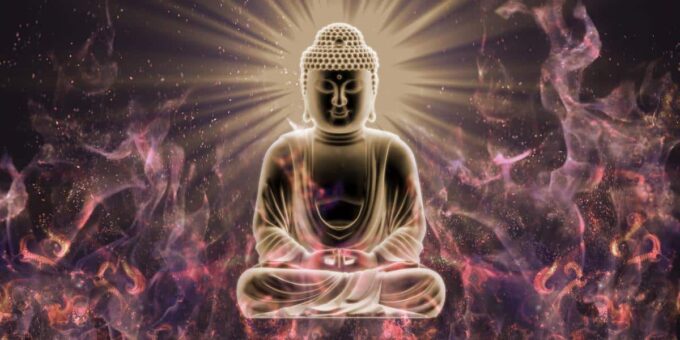The word citta is, in fact, derived from the verbal root “citi” meaning to cognize or to know something as its object. The Pali-English dictionary gives the following basic meanings to term citta:
– The first meaning (v) is to shine, to be bright, variegated, manifold, beautiful, tasty, sweet, spiced, painted.
– The second meaning (derived from the PaIi word for thinking – cinteti) is heart, mind, spirit, soul, thought, conception, consciousness, mood, emotion, spirit, idea, and attitude. The term is usually rendered as mind by the majority of the authoritative translators of Pali. Heart is less used as rendering.
– The third meaning (n) is the name of the first month Chaitra.
In Buddhist psychology, citta is the standard term for the whole of the subjective life, as opposed to rūpa and cetasikas. Citta is defined as awareness of the object. All cittas have in common that they “think” of an object, in other words, being conscious of an object, or cognizing an object. Citta is the seat and organ or center or focus of man’s thought (cetasa citeti). Its most primary function is to think (cinteti) of an object of every kind.
Abhidhamma used three ways of defining the term:
– as agent (citta is that which knows the object),
– instrument (citta is something with the help of which the other concomitants know the object) and
– sheer activity or mere activity (citta is a knowing of the object).
Since it is defined as the awareness of the object, citta can never arise without an object. Whenever there is citta, there must be its object. There must always be an object for citta to arise. Sometimes it may be a vivid object, sometimes it may be an obscure object. A citta cannot arise alone, it has to be accompanied by cetasikas. The citta is the “leader”, while the cetasikas which share the same object perform each their own task.
There is a great variety of cetasikas accompanying the different cittas. Akusala cittas are accompanied by cetasikas which are defilements, whereas kusala cittas are accompanied by cetasikas which are good qualities. Apart from defilements and good qualities, there are also cetasikas which accompany cittas which are unwholesome, cittas which are wholesome and cittas which are neither wholesome nor unwholesome. (In the first book of Abhidhamma, citta is classified according to its nature. That means it is classified according to whether it is wholesome consciousness, unwholesome consciousness and those that are neither wholesome nor unwholesome.)
In accordance with the law of dependent origination (paṭiccasamuppāda), citta is causally and dependently arisen on an object (ārammaṇa), or on the coming together (saṅgati/contact) of mentation (mano) and (dhamma). Its object can be a color (rūpa), sound (sadda), smell (gandha), taste (rasa), something tangible (phoṭṭhabba) and the mental object such as ideas or concepts (dhammā). It is, therefore, neither permanent nor substantial ego-entity (akārakabhāvaṃ). It is not the substantial agent that thinks, that speaks, that feels, or that experiences, but only a series of instances of awareness. In other words, it is merely instrumental and functional in nature.
Citta is the only psychic center responsible for performing the human ethical behavior (karma), whether good (kusala), evil (akusala) and neutral (avyākṛtatva).
According to the nature of being conscious of the object all types of citta – consciousness – are the same. Cittas can be classified into 89 (or 121 types):
– 81 cittas are mundane consciousness and
– 8 cittas are supramundane consciousness.
Cittas are divided into four categories:
– Moral or skillful consciousness (kusala citta) – 21 types
– Immoral or unskillful consciousness (akusala citta) –12 types
– Resultant consciousness (vipaka citta) –36 types
– Inoperative consciousness (kiriya citta) –20 types
From an Abhidhamma standpoint, citta may better be defined as the awareness of an object, since there is no agent like a soul. In Abhidhamma, Citta, Ceta, Cittuppāda, Nāma, Mana, Viññāna are all used as synonymous. From the Abhidhamma perspective, no distinction is made between mind and consciousness. When the so-called being is divided into its two constituent parts, Nāma (mind) is used. When it is divided into the aggregates (Pañcakkhandha), Viññāna is used. The term citta is invariably employed while referring to different classes of consciousness. In isolated cases, in the ordinary sense of mind, both terms Citta and Mana are frequently used.
Citta plays an important role in performing actions, whether moral, emotional, rational or intellectual. Citta is the refuge (paṭisarana) upon which the two mental properties – feeling or affective (vedanā) and perception or ideation (saññā) – depend. The feeling is the hedonic tone of the citta while perception is the rational concerned with knowing and reasoning. In other words, the function of citta is of twofold, negative and positive.
As regards negative function, citta feeling attached to is inclined towards and indulges (adhimuccati) in the pleasure of senses. Due to its clinging to (sajjati) and getting bound up (gayhati) with its sensory objects, citta is defiled and corrupt (vyāsiñcati), by hedonic tendencies, such as greed (lobha), ill-will (dosa), ignorance (moha), shamelessness (anottappa), lack of moral conscience (ahirika), etc. Such a negative tendency is conducive to the rebirth in saṁsāra.
As far as its positive function is concerned, citta can lead one to truth (tathattāya upaneti) by its ethically positive qualities, such as powers of rational faith (saddhā), mindfulness (sati), conscience (hiri), moral shame (ottappa), nongreed (alobha), non-ill-will (adosa), equanimity (tatramajjhattatā), etc. This anti-hedonic tendency leads to the realization of nibbāna.
Thus citta becomes the most prominent role in the world of activities and becoming. Attaining a purified citta corresponds to gain insight into the true nature of the reality. This indicates that a liberated one’s state of mind reflects no ignorance or defilements. As these represent bondage, their absence is described in terms of nirvana (nibbana).
“Well, monks, the world is led by the mind and drawn away by the mind. The world comes under the power of the mind.”
Photo credit : filosofiaamica




